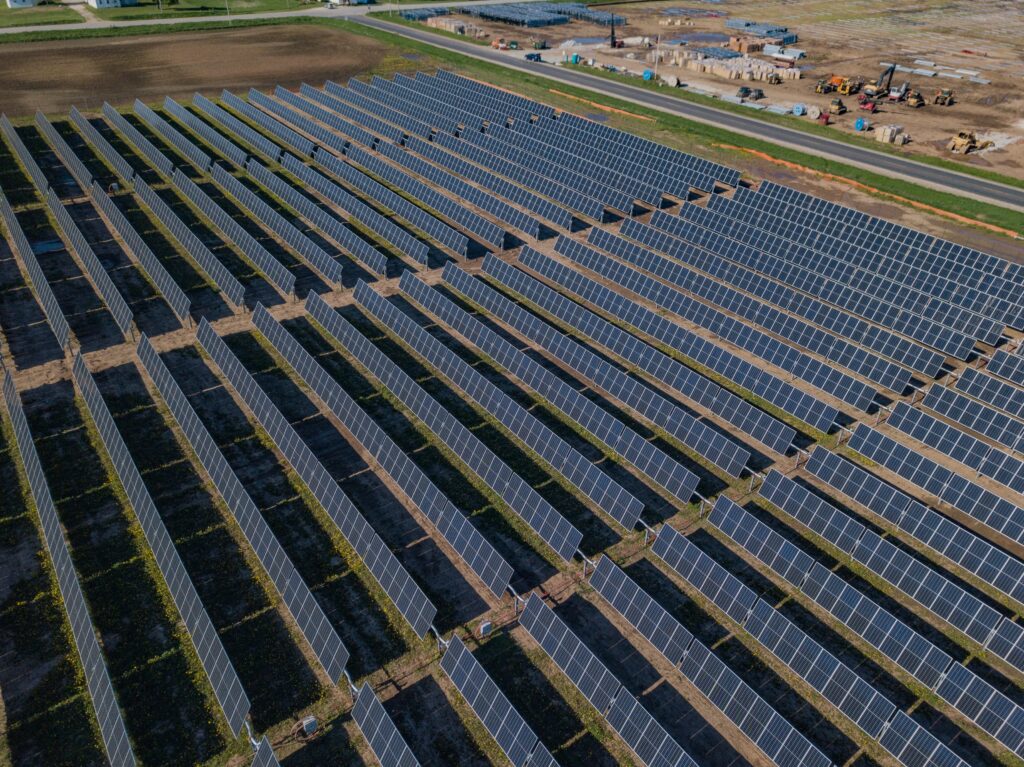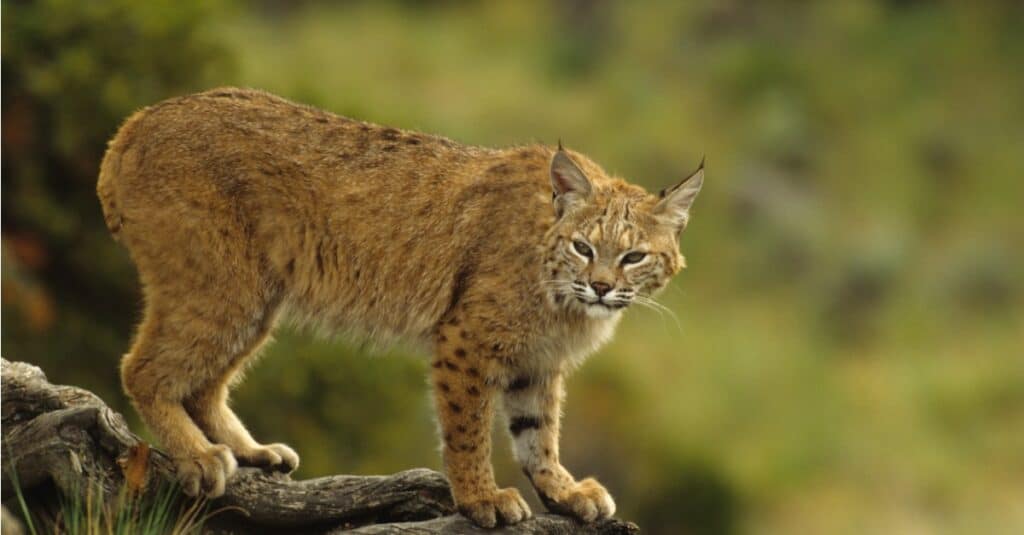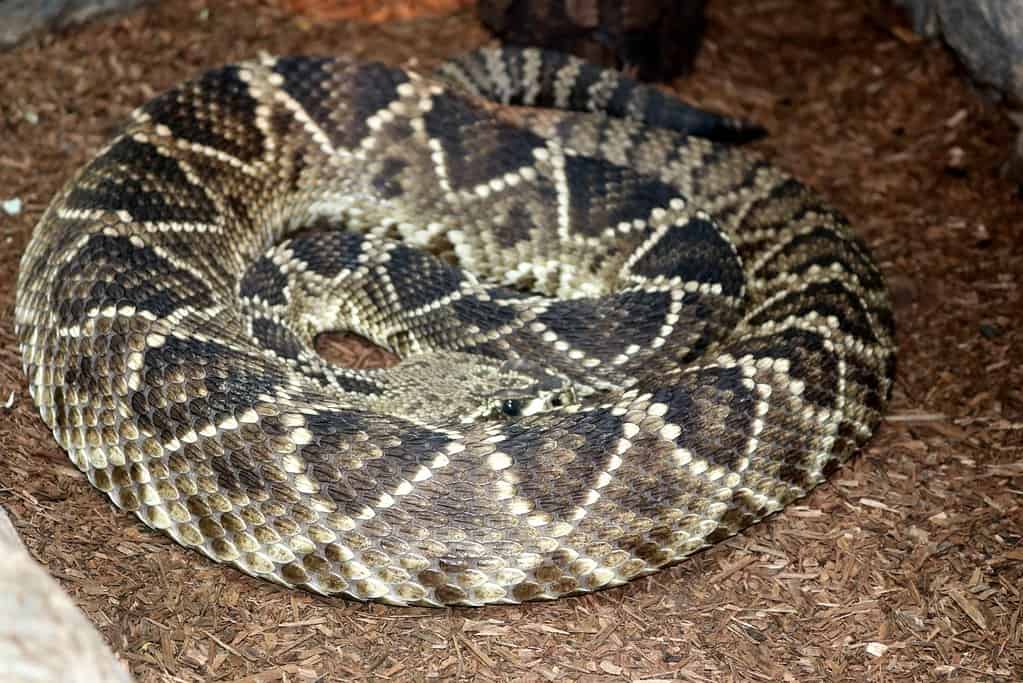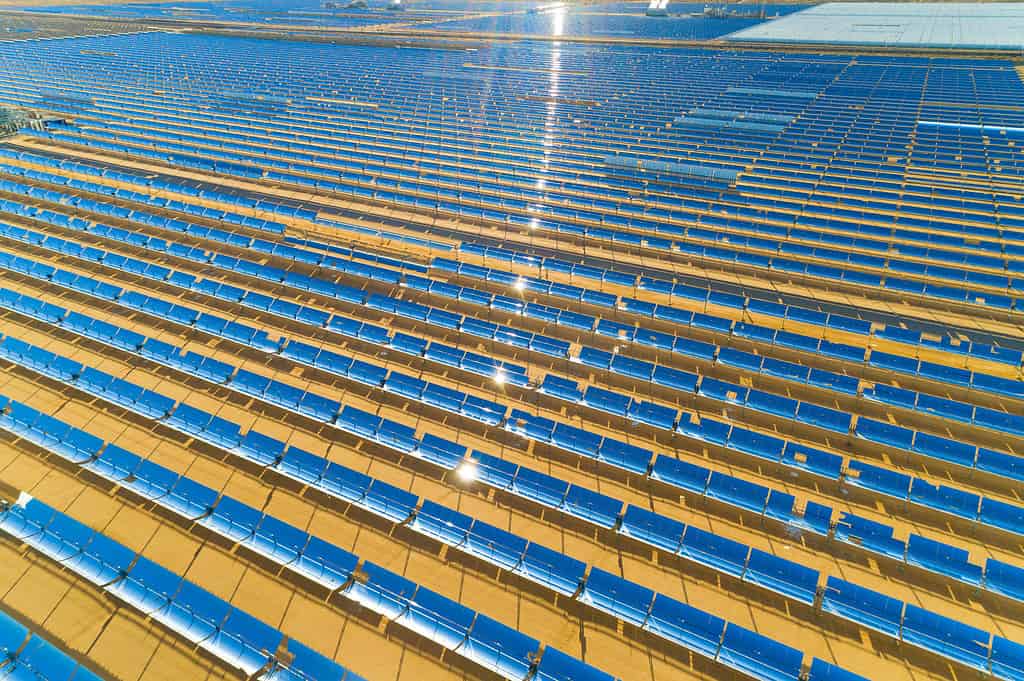Solar Star, California’s most extensive and best-producing solar farm, provides enough clean energy to power 250,000 homes. The farm stands in Kern and Los Angeles counties and is not only the most significant Solar Farm in California but the largest in the world when completed in 2015. The Solar Farm comprises 1.7 million solar panels spread over 13 square kilometers (3,200 acres). That’s 142 football fields or 4 Central Parks!

Solar farms are large plots of land with photovoltaic, or PV, solar panels.
©Roschetzky Photography/Shutterstock.com
Solar Star
California is the leading state in renewable energy and hosts some of the largest solar power plants in the United States. Solar Star produced 579 megawatts of energy, enough to power 255,000 homes. Southern California Edison buys that energy and distributes it to its customers. The farm splits into two installations: Solar Star 1 and Solar Star 2. Solar Star 1 produces 314 MW, and number 2 makes a little less at 265 MW. Solar Star ranks as the largest installed capacity, using 1.7 million solar panels over 13 square kilometers.
Compared to other solar plants, Solar Star is smaller in terms of size. This is because Solar Star uses a smaller number of crystalline silicon modules. Still, the modules they use are higher wattage, higher efficiency, and higher cost with newer technologies that follow the sun’s rotation throughout the day. In addition, the panels at Solar Star clean themselves automatically in a way that uses minimal water than other panels at other farms. These same solar panels also follow a new technology that uses a single-axis tracker to track the sun’s movements across the sky. This new technology makes the panels 25% more efficient than panels that don’t move.

There are over 2,500 solar farms in the United States.
©John Touscany/Shutterstock.com
The designers built Solar Star near Rosamond, California, on “disturbed” land, meaning people have altered or made the land. SunPower Services operates and maintains the farm. The power plant created 650 jobs over three years, and Cleantechnica reported that Solar Star created 40 maintenance jobs and 15 full-time site position jobs over its lifetime. It is hard to put the environmental impact of a project this size into perspective but to try. Solar Star is the ecological equivalent of taking 108,000 cars off the road yearly.
How is Solar Star the Largest Solar Farm in America?
Even though completed in 2015, Solar Star still reigns as the highest-producing solar farm in the United States in terms of power generated. Solar farms in California, like Desert Sunlight and Topaz power plants, produce 550MW each. These solar farms take up more space (3,800 and 4,700 acres compared to Solar Stars’ 3,200), but Solar Star still comes out on top in terms of efficiency per area, based on location and engineering.
What Animals live around Solar Star?
California’s largest solar farm, Solar Star, is located in Rosamond, California, in the Antelope Valley region of Southern California. While the area is predominantly desert and agricultural, several wild animal species can be found in and around Rosamond. In addition, some notable wild animals may inhabit or pass through the area.
Coyotes

Coyotes are common throughout all of California.
©Petr Ganaj/Shutterstock.com
These animals are common throughout California, including the Rosamond area. They are adaptable animals that thrive in various habitats, including deserts and suburban regions.
Bobcats

Bobcats are most active at dawn and dusk.
©iStock.com/twildlife
This native bobcat species is found in the region. They are medium-sized wildcats that are skilled hunters and can adapt to different environments, including semi-arid regions like Rosamond.
Jackrabbits

Rosamond is home to various species of jackrabbits.
©iStock.com/Byrdyak
Rosamond is home to various species of jackrabbits, including the black-tailed jackrabbit. These large hares are known for their distinctive long ears and powerful hind legs.
Ground Squirrels

Baby
uinta ground squirrels
with mother
©Michael Chatt/Shutterstock.com
Several ground squirrels, such as California, can be found in the area. These tiny rodents live in burrows, common in open habitats like grasslands and desert areas.
Rattlesnakes

Eastern diamondback rattlesnake
©Sanjiv Shukla/Shutterstock.com
The Rosamond area is home to various species of rattlesnakes, including the Western diamondback rattlesnake and the Mojave rattlesnake. These venomous snakes are adapted to desert environments and can be encountered in rocky or brushy habitats.
Other Solar Farms in California
Desert Sunlight Farm
The Desert Sunlight Farm is a 550-megawatt photovoltaic power station. It sits approximately six miles north of the rural community of Desert Center in eastern Riverside County, California, in the hot Mojave Desert. The Desert Sunlight photovoltaic solar farm produces 550MW of power capacity. The project was conceptualized by First Solar in 2008, approved in August 2011, and construction started in September 2011 and was finally completed in February 2015. The farm was built on 4,100 acres of land that the US Bureau of Land Management manages.
Desert sunlight has approximately eight million FirstSolar Series 3 Cadmium Telluride (CdTe) thin-film PV modules. The project utilized 70,000t of American steel and generated 550 construction jobs. The PV modules installed at Desert Sunlight don’t require water for electricity generation or cleaning and generate no air, emissions, or waste.
Desert Sunlight can generate 1,060GWh of electricity a year, which can serve 160,000 homes in California and equates to offsetting 300,000t of carbon dioxide emissions a year compared to the use of fossil fuels. The project supported the state’s target to generate 33% of power from renewable resources by 220. In addition to creating 550 construction jobs, it produced 15 permanent jobs and a gross indirect local economic benefit of $336m for Riverside County.
Under two separate power purchase agreements (PPA), 300 MW of renewable energy from Desert sunlight is delivered to Pacific Gas & Electric (PG&E), while the remaining 250MW is provided to California Edison (SCE). The PPAS is valid for 25 years and 20 years, respectively.
Topaz Solar Farm
Topaz Solar Farm is a 550-megawatt photovoltaic power station in San Luis Obispo County, California. Construction on the project began in November 2011 and finished in November 2014. Topaz ranks as one of the world’s largest solar farms but still is not bigger than Solar Star. It has 550MW of power Capacity, and at its total operational capacity, the plant produces enough electricity to power more than 181,000 homes. According to BHE Renewables’ estimates, this is sufficient to remove about 407,000 metric tons of carbon dioxide annually and is equivalent to removing 77,000 cars from the road.
Topaz invested around $2.5bn and created 400 jobs during construction. Covering an area of approximately 4,700 acres, the Topaz Solar Farm stands in unincorporated easter San Luis Obispo County, California, near the small community of California Valley.
Each solar photovoltaic module has a dimension of 4ft by 2ft and weighs 27.5 pounds. These modules mount together on panels supported by steel columns with advanced thin-film attributes capable of generating electricity without emissions, waste, or water use.

Aerial view of a solar farm producing clean, renewable solar energy in California.
©Beach Media/Shutterstock.com
Largest Solar Farm in the World
Bhadla Solar Park is the largest Solar Farm in the world, located in India in the Bhadla village of Jodhpur district in Rajasthan. The park stands in the Thar Desert region, known for its abundant sunlight and favorable conditions for solar power generation.
The solar park covers a vast area of approximately 14,000 acres (5,665 hectares) and has a total installed capacity of 2,245 megawatts (MW), making it one of the largest solar parks in India. Developed in multiple phases by the Solar Energy Corporation of India (SECI) and the Government of Rajasthan. The first phase started in 2015.
Thanks to its strategic location in the Thar Desert, Bhadla Solar Park benefits from the region’s high solar radiation. The ample sunlight maximizes the efficiency of the solar panels and overall energy output, making it an ideal site for solar power generation.
The park utilizes photovoltaic (PV) technology, directly converting sunlight into electricity using solar panels. Designers mounted these panels on fixed structures or solar trackers that optimized their orientation to capture the maximum amount of solar energy.
The electricity generated from Bhadla Solar Park connects to the grid, contributing to the overall power supply. The park is crucial in meeting the renewable energy targets the Government of India sets and helps reduce greenhouse gas emissions.
Aside from its environmental benefits, Bhadla Solar Park has also positively impacted the local economy. It has created job opportunities during its construction and ongoing operation. Furthermore, the solar park has attracted investment to the region, contributing to its economic development.
What is Solar Energy?
Solar energy comes in all shapes and sizes, from single-panel-powered gadgets in rooftop form over your house to large energy-producing solar farms. The power transforms sun energy and converts it into thermal or electrical energy. As a result, solar energy ranks as the cleanest and most abundant energy source available, and California has the richest solar resources in the world. Solar technologies harness for various uses, including electricity, providing light or a comfortable interior environment, and heating water for domestic, commercial, or industrial use.
How is Solar Used?
Solar energy, described as a very flexible energy technology, can be built to be distributed. Solar technologies convert sunlight into electrical energy through mirrors that concentrate solar radiation. This energy generates electricity and stores it in batteries or thermal storage.
What is the Future of Solar Energy in California?
Solar energy has been a rapidly growing sector in California. It is expected to play a significant role in the state’s future energy. California has been a leader in solar energy adoption and has set ambitious renewable energy goals. This reduces greenhouse gas emissions and combat climate change.
California established a Renewable Portfolio Standard, which mandates that a certain percentage of the state’s electricity comes from renewable sources. The goal is to reach 60% renewable energy by 2030 and 100% clean energy by 2045. Solar power expects to significantly contribute to achieving these targets because of its abundance and potential for scalability.
In addition to distributed solar installations, utility-scale solar projects expect to play a significant role in California’s renewable energy future. Large-scale solar farms and power purchase agreements (PPAs) with utilities are instrumental in supplying clean electricity to the grid. These projects contribute substantially to meeting the state’s renewable energy targets. This further solidifies solar energy’s position in California’s energy mix.
The future of solar energy in California shines bright. With ambitious renewable energy goals, declining costs, distributed generation, energy storage integration, supportive programs, and utility-scale solar projects, the state poises to continue its leadership in the solar energy sector. As technological advancements and policy developments unfold, solar power will play a vital role in California’s transition to a cleaner, more sustainable energy future.
The photo featured at the top of this post is © Beach Media/Shutterstock.com
Thank you for reading! Have some feedback for us? Contact the AZ Animals editorial team.






